Hydrogen sorption efficiency of titanium decorated calix[4]pyrroles†
Abstract
Hydrogen is a promising and the most environmentally friendly energy carrier due to its renewable nature and it is expected to replace fossil fuels. The hydrogen storage properties of Ti decorated calix[4]pyrrole (CXP) and octamethylcalix[4]pyrrole (MeCXP) have been reported. The structure, stability and hydrogen loading efficiency of Ti decorated CXP and MeCXP have been studied based on density functional theory with the Minnesota 06 (M06) functional and the 6-311G(d,p) basis set. Ti binds with the pyrrole rings of CXP and MeCXP from outside of each ring by Dewar coordination. It is found that Ti decorated CXP and MeCXP have hydrogen wt% 9.7 and 10.5 respectively. The usable hydrogen wt% is found to be 6.35 and 5.20 for CXP and MeCXP respectively. The stability of Ti decorated CXP and MeCXP is studied by calculating global reactivity parameters, which follow maximum hardness and minimum philicity principles. The calculated adsorption and desorption energy values are found to be low and decrease on H2 adsorption in both the Ti decorated systems. The molecular dynamics simulations indicate that the hydrogen starts releasing at 273 K and all the hydrogen molecules are released by 473 K from both the systems. These predictions pave the way to reversibly store hydrogen efficiently with high gravimetric storage capacity in CXP and MeCXP systems.
![Graphical abstract: Hydrogen sorption efficiency of titanium decorated calix[4]pyrroles](/en/Image/Get?imageInfo.ImageType=GA&imageInfo.ImageIdentifier.ManuscriptID=C7CP06781J&imageInfo.ImageIdentifier.Year=2017)


 Please wait while we load your content...
Please wait while we load your content...